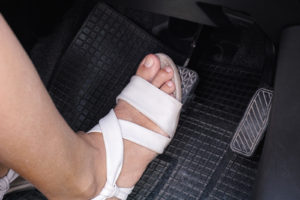7 Steps to Take When Your Car Brakes Stop Working
June 18th, 2020 by Fix Auto USA

The moment your car brakes stop working, panic begins. Fortunately, if you notice your car brakes going out, there are various ways to stop your vehicle without causing an accident or collision.
What to Do If Your Car Brakes Stop Working
When your brakes go out, here’s what you need to do:
1. Try the Brake Pedal Again
If you press down your car’s brake pedal at first and nothing happens, press it down firmly on the pedal to try to activate the brakes once again. Most cars feature a dual braking system, and if your car brakes stopped working suddenly, it might be due to the fact that only a portion of this system is malfunctioning. By applying strong and consistent pressure to the brake pedal, you may be able to get your car to slow down and stop.
2. Engage the Emergency Brake
If your car’s primary brakes are not working, slowly pull the emergency brake handle. Or, if your vehicle has an emergency brake pedal, press down on the pedal until your car comes to a full stop.
Your vehicle’s emergency brake works independently from your car’s primary brakes. But, keep in mind that stopping your car after applying the emergency brake will take longer than it would if you used your vehicle’s primary brakes.
3. Shift into a Lower Gear
If your car has an automatic transmission, take your foot off the accelerator to shift into a lower gear. If your vehicle has a manual transmission, move down gear to gear to slow down and stop your car.
Do not shift your car into neutral, as this could cause your vehicle to coast. Instead, shift into a lower gear and pump the brake pedal to build pressure. Once your car’s speed declines, engage the parking brake.
4. Move Off the Road
Get your car safely off the road as soon as you can. If you’re on a highway, try to move your car into the right lane safely. If possible, move your vehicle into a parking lot or a safe location off the main street.
Use your directional and beware surrounding traffic as you move your car off the road. Avoid any potential road dangers and activate your car’s hazard lights or use your vehicle’s lights and horn to alert other motorists as needed.
5. Turn Off Your Car
Do not turn off your car until it has come to a complete stop. Because, even though it may seem like a good idea to turn off your car to slow it down, doing so can be dangerous. In this instance, your car’s power steering will shut down, which can make it difficult to steer your vehicle. Plus, removing the key from your car’s ignition can cause the steering wheel to lock into place.
Once your car is stopped, signal for help. Set up reflective triangles or flares around your vehicle if they are available. Also, stay away from oncoming traffic, and do not stand next to or behind your car.
6. Contact a Tow Company
Reach out to a tow company to have your car towed to your home or an auto body repair shop. If you have roadside assistance as part of your insurance coverage, you can use it to get your car towed where you want it to go.
In addition, don’t hesitate to call the police for assistance. The police can help you get in contact with a tow company and ensure you are safe until a tow truck arrives.
7. Get Your Brakes Inspected
There is no need to leave anything to chance, particularly when it comes to your car brakes. Get your brakes inspected by auto body shop professionals, and you can identify and correct any brake problems.
Auto body shop professionals can perform a comprehensive brake inspection to determine why your car brakes stopped working. They can also offer tips and recommendations to help you avoid future brake problems.
How to Avoid Brake Problems
Your car brakes are critical, and you need them to perform properly. Thankfully, there are several things you can do to avoid brake problems, such as:
1. Identify the Warning Signs of Defective Brakes
Common warning signs of defective brakes include:
- Screeching, squealing, or other strange noises occur when you press down on the brake pedal
- Vibration from the brake pedal or steering wheel
- Pungent burning smell comes from the tires
- Brake warning light turns on
- Brake pedal must be pressed down farther than usual to activate the brakes
If you notice any of these warning signs, don’t wait to get help. Visit an auto body shop, and you can get your brakes evaluated as soon as possible.
2. Have the Brakes and Brake Pads Inspected Annually
Set up a date and time to have your car brakes and brake pads inspected by auto body shop professionals at least once a year. This allows you to receive insights into the condition of your brakes and brake pads and address any brake issues.
3. Check the Brake Fluid Regularly
Assess your car’s brake fluid level approximately every few months. The brake fluid reservoir has lines that indicate “maximum” and “minimum” levels. If the brake fluid falls below the minimum level, visit an auto body shop to ensure it can be adequately refilled. You should also review your car’s owner’s manual to find out how frequently you should change your vehicle’s brake fluid, as the length of time required for a brake fluid change varies based on car make and model.
Prioritize car brake maintenance and repairs, and you can avoid brake problems that result in brake failure.
Welcome to
Fix Auto USA
We are the premier independent body shop network delivering world-class customer service and high-quality collision repairs across the U.S.
Learn About Us





